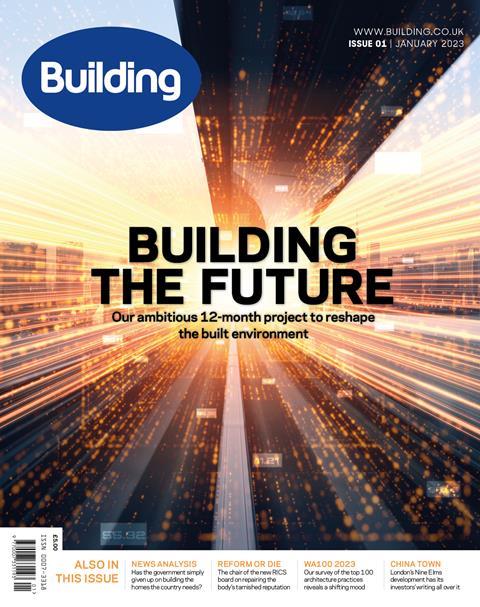In this anniversary year we have launched the Building the Future Commission to identify how construction can change and improve – we also look back at our long heritage by digging into the archive
This is the year for thinking big. In celebration of Building’s 180th anniversary this week we officially launched the Building the Future Commission - an ambitious 12-month project looking at how to unlock the potential of the construction industry.
Since we started publicising the commission readers from all corners of the industry have welcomed Building taking a positive stance and using its influence as one of the oldest trade publications to highlight how construction and the built environment more generally can improve. Through the commission we will be talking to the companies and individuals who are not content with the status quo and are shaking things up.
Our commission will tackle eight core themes that we think are vital for a thriving sector. You can read about the detail behind those themes – which cover everything from housing, infrastructure and building safety to skills, net zero, placemaking, diversity and project delivery – in the coming days and weeks and in our digital edition.

We hope that by reaching out to you, our readers, and the wider industry we can provide a platform for innovative ideas and best practice. It is a well-known fact that construction as a sector is fragmented – and so one of our objectives this year is to join some of the dots to provide an overview of the challenges and the opportunities it faces.
The commission will distil all our work into a manifesto for change
As we set out on this journey, we have 19 high-profile commissioners on board helping us navigate our way through, and we have linked up with Constructing Excellence so we can tour the country with regional roundtable debates. We also have the backing of our headline supporters Gleeds and Fenwick Elliott.
>> All our commission content in one place
And after 12 months the commission will distil all our work into a manifesto for change, a set of key recommendations for the eyes of government ministers and industry leaders. These proposals will be landing just as political parties are gearing up for the next election campaign and we hope it feeds into the wider national debate.
But the commission’s ambitions go beyond the short-term political cycle, as Katy Dowding, executive vice president at Skanska and one of our commissioners, says: “The commission has the potential to deliver something that will benefit the industry and effect genuine change for many years to come.”
This is an aspiration shared by all of our commissioners, some of whom we have interviewed in our digital edition where you can find out more about their areas of expertise, and what they think construction does well and where it needs to improve.
This is just the beginning: over the coming weeks and months, check out our website for frequent case studies, interviews, debates, analysis and much more – all of which will seek to unpack the issues and start to point to solutions.
Also worth a mention as part of our anniversary celebrations is our From the Archives series. Our first instalment travels back to 1847 with an editorial from The Builder – as we were then known – in praise of the construction of the Palace of Westminster. The building works, which began in 1840, had been harshly criticised for delays – a familiar theme for those working projects in the public eye today.
The article we have unearthed is a rebuke to the critics, carefully laying out the scale and complexity of the works, which the editor clearly felt was part of the publication’s mission to provide essential detail that improved readers’ understanding. That is still very much Building’s mission, and we hope that through our work with the commission and beyond we can help create a vision for construction’s future.
Defying expectations but for how long?
Last week’s GDP figures came as a surprise. The UK economy grew 0.1% in November, helped by a boost from the World Cup as pubs and restaurants benefited from people going out to watch the football.
Economists now say it is less clear that the UK will enter a recession, though the economy is still far from thriving with output over the three months down 0.3%.
And what role is construction playing in any attempt to stave off two quarters of shrinking output? One reading of the data is quite positive: parts of the construction sector saw month-on-month growth, such as the buoyant infrastructure sector, which rose 4.2% and well above pre-covid levels. Public sector building, private industrial work, and private commercial all saw growth too.
Despite this the industry posted flat growth overall, dragged down by a slowdown in housing. The overall drop in housebuilding output was 4.9% – an inevitable consequence of rising mortgage rates and the fallout from the mini-Budget.
But beyond the challenges facing housebuilders, what does 2023 have in store? As Aecom’s latest market forecast points out, 2022’s steady rates of growth mean the market enters this year with workloads that could insulate it from slowdowns in other sectors. It is also encouraging that material price inflation is easing off as energy prices start to stabilise.
What we cannot know is how well construction demand will hold up in the medium term – meanwhile, the skills shortage means wage inflation remains a real constraint. So while the latest output figures beat expectations, it is unlikely they will change sentiment; most construction bosses will be planning for a tightening market in the coming months.
Chloe McCulloch is Building’s editor






























No comments yet